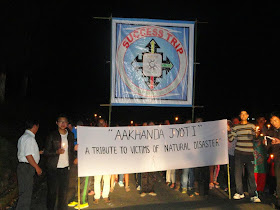VISHNU NEOPANEY
GANGTOK, 20 Sept: PS Tamang [Golay] is now a former MLA. Speaker of the Sikkim Legislative Assembly today passed an order disqualifying the Upper Burtuk MLA from the House. The disqualification follows from Mr. Tamang’s resignation from the ruling party on whose ticket he had been elected on in 2009. The resignation would have automatically attracted disqualification on the basis of anti-defection rules. The stage is now set for bye-elections for Upper Burtuk constituency and it will interesting to see whether these are called, when they are called, who participates and what level of contest takes place.
Speaker KT Gyaltsen, while passing the order on Mr. Tamang’s disqualification, explains that the decision has been prompted by paragraph 2(1)(a) of the Tenth Schedule of the Constitution of India. The disqualification comes into effect immediately i.e. from 20 Sept itself.
Mr. Tamang, it may be recalled, had circulated his resignation from primary membership of the ruling Sikkim Democratic Front on 04 September. With this, as per Article 191 of the Constitution of India under ‘Disqualifications for Membership’ Sub-Section 2, Mr. Tamang has been disqualified from remaining a member of the State Legislative Assembly, it is informed.
The Speaker, it is informed, passed the order after the SDF party accepted Mr. Tamang’s resignation and recommended his disqualification to the Speaker.
The Sikkim Legislative Assembly secretariat has also confirmed the rebel MLA’s disqualification.
Interestingly, the first notification issued by the SLA secretariat today had misspelled disqualify and a corrected notification was reportedly issued after this typo was pointed out.
As per the ‘Anti-Defection Law’ underlined in Tenth Schedule of Articles 102(2) and provisions as to disqualification on ground of defection says in Paragraph 2sub section ‘(1) Subject to the provisions of [paragraphs 4 & 5, a member of a House belonging to any political party shall be disqualified for being a member of the House- (a) if he has voluntarily given up his membership of such political party; or (b) if he votes or abstains from voting in such House contrary to any direction issued by the political party to which he belongs or by any person or authority authorized by it in this behalf, without obtaining, in either case, the prior permission of such political party, person or authority and such voting or abstention has not been condoned by such political party, person or authority within fifteen days from the date of such voting or abstention. ‘A person shall be disqualified for being a Member of the Legislative Assembly or Legislative Council of a State if he is so disqualified under the Tenth Schedule.’
GANGTOK, 20 Sept: PS Tamang [Golay] is now a former MLA. Speaker of the Sikkim Legislative Assembly today passed an order disqualifying the Upper Burtuk MLA from the House. The disqualification follows from Mr. Tamang’s resignation from the ruling party on whose ticket he had been elected on in 2009. The resignation would have automatically attracted disqualification on the basis of anti-defection rules. The stage is now set for bye-elections for Upper Burtuk constituency and it will interesting to see whether these are called, when they are called, who participates and what level of contest takes place.
Speaker KT Gyaltsen, while passing the order on Mr. Tamang’s disqualification, explains that the decision has been prompted by paragraph 2(1)(a) of the Tenth Schedule of the Constitution of India. The disqualification comes into effect immediately i.e. from 20 Sept itself.
Mr. Tamang, it may be recalled, had circulated his resignation from primary membership of the ruling Sikkim Democratic Front on 04 September. With this, as per Article 191 of the Constitution of India under ‘Disqualifications for Membership’ Sub-Section 2, Mr. Tamang has been disqualified from remaining a member of the State Legislative Assembly, it is informed.
The Speaker, it is informed, passed the order after the SDF party accepted Mr. Tamang’s resignation and recommended his disqualification to the Speaker.
The Sikkim Legislative Assembly secretariat has also confirmed the rebel MLA’s disqualification.
Interestingly, the first notification issued by the SLA secretariat today had misspelled disqualify and a corrected notification was reportedly issued after this typo was pointed out.
As per the ‘Anti-Defection Law’ underlined in Tenth Schedule of Articles 102(2) and provisions as to disqualification on ground of defection says in Paragraph 2sub section ‘(1) Subject to the provisions of [paragraphs 4 & 5, a member of a House belonging to any political party shall be disqualified for being a member of the House- (a) if he has voluntarily given up his membership of such political party; or (b) if he votes or abstains from voting in such House contrary to any direction issued by the political party to which he belongs or by any person or authority authorized by it in this behalf, without obtaining, in either case, the prior permission of such political party, person or authority and such voting or abstention has not been condoned by such political party, person or authority within fifteen days from the date of such voting or abstention. ‘A person shall be disqualified for being a Member of the Legislative Assembly or Legislative Council of a State if he is so disqualified under the Tenth Schedule.’



















